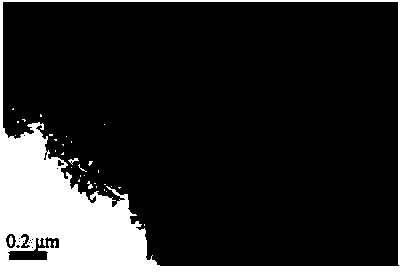Nanostructure tungsten-zirconium carbide alloy and preparation method thereof
A nanostructure, zirconium carbide technology, applied in the field of material science, can solve the problems of brittle fracture, reduced strength of pure tungsten, and reduced toughness of tungsten, and achieve high-temperature strength and toughness, high-temperature stability, mechanical properties and high-temperature stability Good performance, the effect of improving strength and high temperature performance
- Summary
- Abstract
- Description
- Claims
- Application Information
AI Technical Summary
Problems solved by technology
Method used
Image
Examples
Embodiment 1
[0038] The concrete steps of preparation are:
[0039] Step 1, according to the ratio of 99.8wt% by weight: 0.2wt%, the metal tungsten powder and zirconium carbide powder are placed in an argon atmosphere and ball milled to obtain a mixture; wherein the particle size of the metal tungsten powder is 0.2μm, the particle size of zirconium carbide powder is 10nm.
[0040] In step 2, first press the mixture under a pressure of 300MPa to form a green body, then place the green body in a hydrogen atmosphere (or a vacuum with a vacuum degree of ≤10Pa), and sinter and shape it at 1500°C.
[0041] Step 2 can also adopt the direct thermocompression molding process, as follows:
[0042] The mixture is placed in a hydrogen atmosphere (or a vacuum with a vacuum degree of ≤10Pa), and is hot isostatically pressed and sintered at a pressure of 100MPa and a temperature of 1500°C.
[0043] Alternatively, the mixture is placed in a hydrogen atmosphere (or a vacuum with a vacuum degree of ≤10 Pa...
Embodiment 2
[0049] The concrete steps of preparation are:
[0050] Step 1, according to the ratio of 98.5wt% by weight: 1.5wt%, the metal tungsten powder and the zirconium carbide powder are ball-milled in alcohol and mixed evenly; wherein, the particle size of the metal tungsten powder is 0.6 μm, and the zirconium carbide powder The particle size of the body is 50nm, and they are mixed by ball milling in an argon atmosphere to obtain a mixture.
[0051] Step 2, first press the mixture under a pressure of 300MPa to form a green body, then place the green body in a hydrogen atmosphere or vacuum, and sinter at 1675°C;
[0052] Step 2 can also adopt the direct thermocompression molding process, as follows:
[0053] The mixture is placed in a hydrogen atmosphere or a vacuum atmosphere, and is hot isostatically pressed and sintered at a pressure of 130MPa and a temperature of 1625°C;
[0054]Alternatively, the mixture is placed in a hydrogen atmosphere or a vacuum atmosphere, and then formed...
Embodiment 3
[0056] The concrete steps of preparation are:
[0057] Step 1, according to the ratio of 99.00wt% by weight: 1.0wt%, the metal tungsten powder and zirconium carbide powder are uniformly mixed with a mixer in a nitrogen atmosphere to obtain a mixture; wherein the particle size of the metal tungsten powder is 1μm, the particle size of zirconium carbide powder is 100nm.
[0058] Step 2, first press the mixture under a pressure of 400MPa to form a green body, then place the green body in a hydrogen atmosphere, and sinter it at 2300°C;
[0059] Step 2 can also adopt the direct thermocompression molding process, as follows:
[0060] The mixture is placed in an argon atmosphere, hot isostatically pressed and sintered at a pressure of 150MPa and a temperature of 2000°C;
[0061] Alternatively, the mixture is placed in an argon atmosphere or vacuum, and then formed by spark plasma sintering at a pressure of 50 MPa and a temperature of 1750°C.
PUM
| Property | Measurement | Unit |
|---|---|---|
| Particle size | aaaaa | aaaaa |
| Particle size | aaaaa | aaaaa |
| Tensile strength | aaaaa | aaaaa |
Abstract
Description
Claims
Application Information
 Login to View More
Login to View More - R&D
- Intellectual Property
- Life Sciences
- Materials
- Tech Scout
- Unparalleled Data Quality
- Higher Quality Content
- 60% Fewer Hallucinations
Browse by: Latest US Patents, China's latest patents, Technical Efficacy Thesaurus, Application Domain, Technology Topic, Popular Technical Reports.
© 2025 PatSnap. All rights reserved.Legal|Privacy policy|Modern Slavery Act Transparency Statement|Sitemap|About US| Contact US: help@patsnap.com


